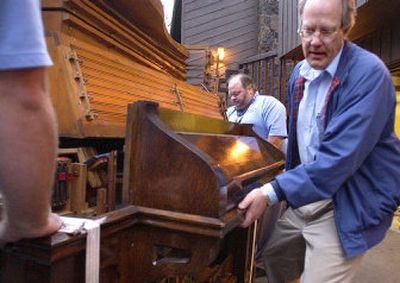St. Al’s organ back

Weekday afternoons, St. Aloysius Catholic Church is so silent you can almost hear the holy water evaporating in the narthex.
But there was a melody Wednesday as Steve Schaubel and Doug Pottratz, huddled behind the chancel, carried out what the men are calling “organ transplant.”
“I can’t believe it’s been in boxes and 80 years later, it can be put back together and it sounds great,” said Schaubel, as he depressed the keys of a 115-year-old reed organ and filled the air with the sound of flutes.
Smiling in agreement, Pottratz expressed amazement that the organ even exists. This reed organ, rescued from a thrift store 21 years ago, is the original organ of St. Aloysius Church. Removed in the 1920s, it finally made its way home Wednesday after a long and somewhat mysterious absence.
Pottratz, an Episcopalian, rebuilt the organ from scratch and returned it to its rightful owner.
“It was in a pile of wood when I found it,” said Pottratz, who located the instrument at a St. Vincent de Paul thrift store. “I eventually saw pipes and a keyboard and knew what it was.”
The organ marks a week of serious restoration for the church. As Pottratz and Schaubel assembled the organ beneath the cupola inside the church, construction workers outside were removing the 3,000-pound bell from St. Aloysius’ east tower. The bell has been listing for decades, ever since Mt. St. Helens ash plugged the tower’s gutters and water rotted the bell’s wood frame. A new steel frame is being installed and the bell, which hasn’t sounded since Pope John Paul II died April 2, 2005, should sound by Christmas.
The organ could play this weekend.
Pottratz wasn’t looking for an organ to rebuild when he found the instrument in pieces. He had been lured to the store by the promise of dark antique oak. A friend had spotted the wood in a pile at the back of the store and knew Pottratz, a woodworker, would be interested in the thick slabs. The hundreds of other organ pieces were scattered throughout the store.
For $300, Pottratz bought the organ and all the stories that came with it. A store worker informed him that Bing Crosby had played the organ at St. Aloysius Church on the Gonzaga University campus. There was a flier at least proving the instrument and Spokane’s favorite crooner had occupied St. Al’s at the same time. Scarred from years of storage, the organ had some secrets to tell, also.
There was a signature signed and dated on the organ’s bellows, “Charles W. White – July 29, 1891.” Pottratz presumed White was either the builder or a tuner. The organ was also stamped with the number 4613, suggesting it was one of several of its kind, a Vocalion reed organ. The final secret was the Bekins storage stickers pasted all over the Vocalion’s larger pieces; this instrument had been in storage for some time, possibly 50 years.
The Vocalion was St. Al’s first organ. It was part of the original St. Aloysius church, built in 1892 and no longer in existence. The organ then moved to the “new” St. Aloysius Church, completed in 1911. But the organ was replaced by a much larger Kilgen Company pipe organ in 1927 and given to a church parishioner.
Eventually, the organ was given to the now defunct Museum of Native American Cultures at Gonzaga. That museum merged its collection with the Northwest Museum of Arts and Culture. The Vocalion was relegated to St. Vincent de Paul.
Pottratz put the organ in storage for about a decade before tinkering with it in the 1990s. He had no blueprints from which to work, only the contact numbers of a few reed organ fanatics he’d met through research.
There were 494 reeds and just as many fragile wooden push rods to breath life into the organ at the push of an ivory key. Any part that appeared worn out, Pottratz crafted a new one from scratch, though he had no idea if he had all the parts he needed. He just kept plugging away, connecting what he thought were the right pieces of this musical puzzle until there were only four parts left, which he hoped were spares. There were no spares; an organ maker in San Francisco set Pottratz straight on where the parts went.
Pottratz finished the project, though he had no idea if the organ sounded as it should – he’d never played an organ.
“I can play ‘Little Brown Jug,’ but that’s about it,” Pottratz said.
But St. Aloysius Church sent Schaubel out to Spokane Valley to investigate after Pottratz called asking if the church wanted its organ back. Pottratz assembled the organ on the deck behind his house off Sullivan Road so Schaubel could examine it. More than 8 feet tall, the organ was too big for the ceilings in Pottratz’s home.
Schaubel sat on the sunny patio with the piney Bella Vista hillside in front of him and grazing meadows along South Sullivan Road at his back.
For the first time in possibly 50 years, the Vocalion’s bellows took a deep breath and the music director played “Love Divine, All Loves Excelling.”
The sound moved Pottratz to tears. It was just like church.